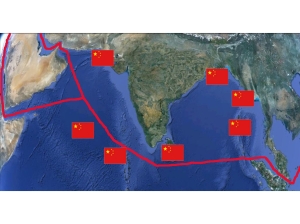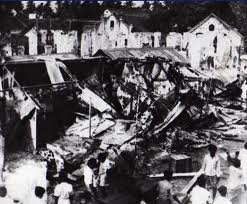 The notion of the String of Pearls is an American hypothesis about China’s containment of India. All the facts indicate that China is building a network of harbour facilities from the Corn of Africa, the Persian Gulf up to the shores of Indo-China. These line of ports crosses the entire Indian Ocean so it wouldn’t be wise to deny the reality of these system of of harbours. And we can keep on calling it with the name of “String of Pearls”. But it is important to investigate the purpose of these facilities. In the American definition, it is an expansive military strategy to encircle India. It suggests that any move to consolidate the String or to add another Pearl, is an offensive step against India.
The notion of the String of Pearls is an American hypothesis about China’s containment of India. All the facts indicate that China is building a network of harbour facilities from the Corn of Africa, the Persian Gulf up to the shores of Indo-China. These line of ports crosses the entire Indian Ocean so it wouldn’t be wise to deny the reality of these system of of harbours. And we can keep on calling it with the name of “String of Pearls”. But it is important to investigate the purpose of these facilities. In the American definition, it is an expansive military strategy to encircle India. It suggests that any move to consolidate the String or to add another Pearl, is an offensive step against India.
It is well known that the primary goal of the String is to secure the energy supply of China. More than 80% of China’s imported fuel passes along that route. So it is an obvious strategy to establish a network of military facilities to safeguard such vital energy line. Especially if you consider the bottleneck of the Malacca Straits, where an American fleet is patrolling a very short sea passage. Very easily relatively few American naval forces could choke completely the import of energy. It is important to note also that in the future the percentage of energy import will grow significantly. The String system therefore is a defensive strategy against the USA.
The question now becomes: how India is affected by China’s naval presence in the Indian Ocean? This of course is an important obstacle in the Indian aspirations of becoming a regional super-power, in the Indian Ocean in particular. The fact is that though India is surrounded by water, all its strategic interests are concentrated on the mainland. The crucial one is per definition the border with Pakistan. A secondary, but important issue is with China itself on the #Andra Pradesh. Minor reasons to exercise geopolitical power lie with Nepal, Burma and Bangladesh. All on land. The only strategically relevant issue on the sea is with Sri Lanka, but the proximity is so close, that you could consider it with the land group. A lot of attention has been grabbed by the Pearl in Hambatota, Sri Lanka. Although there is no doubt that this facility will serve the Chinese maritime presence when it will be needed, it is also foolish to think that China will count on that stronghold to obstacle India in case of a confrontation. Sri Lanka is a domestic issue for India and any military escalation will see New Delhi overwhelms Colombo and any other country on its side.
 The fact is that the Indian presence in the Indian Ocean is so firm that it will never really be excluded. Of course the Chinese presence can shadow all the imperialistic aspirations of New Delhi in the region, and yet, besides prestige, it is difficult if not impossible to worry the Indian presence in its own waters.
The fact is that the Indian presence in the Indian Ocean is so firm that it will never really be excluded. Of course the Chinese presence can shadow all the imperialistic aspirations of New Delhi in the region, and yet, besides prestige, it is difficult if not impossible to worry the Indian presence in its own waters.
The real reason is that the USA suffer even more distance that China from the Indian Ocean and the String of Pearls is seriously menacing the American presence. Washington is heavily worried by being cut off from the region. So we can consider the String of Pearls almost entirely an anti-American defensive strategy.
 We can conclude with a last reflection: if it is a China-American issue, what is the involvement of India? In the first place, the USA are uncomfortable in admitting their worries about their own containment; second they want to co-opt India on their side and convice New Delhi that they share values, goals and most of all, enemies. What is more surprising is that Beijing didn’t do much to change this perception. I suggest that China prefers to pretend of having a fictional confrontation with India, than to admit the real friction with the USA. The battle with supremacy with the USA is global and it has the potential to be nasty and dangerous, especially for the economic well-being of the Chinese people, given the mutual business relations. A confrontation with India can always be reconsider under the historical issues. And even a open, circumstanced war-fare will have very limited consequences. So for the Chinese interests is better to talk fictionally of the India’s containment, rather that facing the real rivalry with the USA.
We can conclude with a last reflection: if it is a China-American issue, what is the involvement of India? In the first place, the USA are uncomfortable in admitting their worries about their own containment; second they want to co-opt India on their side and convice New Delhi that they share values, goals and most of all, enemies. What is more surprising is that Beijing didn’t do much to change this perception. I suggest that China prefers to pretend of having a fictional confrontation with India, than to admit the real friction with the USA. The battle with supremacy with the USA is global and it has the potential to be nasty and dangerous, especially for the economic well-being of the Chinese people, given the mutual business relations. A confrontation with India can always be reconsider under the historical issues. And even a open, circumstanced war-fare will have very limited consequences. So for the Chinese interests is better to talk fictionally of the India’s containment, rather that facing the real rivalry with the USA.
 It is possible that in the future the positions will change, that India’s strategic relevance will grow up to become a real competitors for Chinese supremacy. I suspect that even in this case it will be more a land-based confrontation rather than a naval one.
It is possible that in the future the positions will change, that India’s strategic relevance will grow up to become a real competitors for Chinese supremacy. I suspect that even in this case it will be more a land-based confrontation rather than a naval one.
As a final remark I have to admit the appealing of the theory of the String of Pearls: a concept concisely expressed in an image, whose representation power seems to be self-explaining. It is a fortunate, well-thought artefact of geopolitical propaganda. My impression that is even too good to be real. But sometimes art not only precedes life, it can also lead it.













